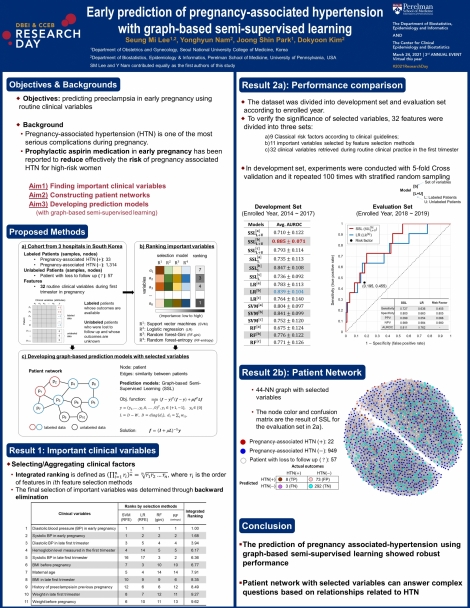Yonghyun Nam
Early prediction of pregnancy-associated hypertension with graph-based semi-supervised learning

Presenter
Flash Talk Presenter
- Postdoctoral Researcher
- Reserch Interest: Graph-based machine learning; Semi-supervised learning; Biological networks
Abstract
Background: Pregnancy-associated hypertension (HTN) is one of the most serious complications during pregnancy. Prophylactic aspirin medication in early pregnancy has been reported to reduce effectively the risk of pregnancy-associated HTN for high-risk women. A few studies tried to predict pregnancy-associated HTN using machine learning methods but failed to show robust performance. Here, we selected important clinical variables using feature selection methods and developed a prediction model for pregnancy-associated HTN using graph-based semi-supervised learning (SSL).
Methods: This is a secondary analysis from a prospective study of healthy pregnant women. For ranking/selecting variables, four feature selection methods were applied to elucidate between 32 routine clinical variables in the first trimester of pregnancy and pregnancy-associated HTN. Then, a patient network with selected variables was constructed to recognize patients with similar patterns. To predict pregnancy-associated HTN with exploiting the underlying network structure of patients, a graph-based SSL was employed.
Results: A patient network was constructed with 1,401 pregnant women, of which 33 women had developed pregnancy-associated HTN. 11 clinical factors (out of 32 routine variables) were selected from the feature selections. We compared the prediction performances with four machine learning methods, including graph-based SSL, logistic regression, support vector machine, and random forest, with 5-fold cross validations. The graph-based SSL using selected 11 clinical factors has achieved the best prediction performance with an average AUROC of 0.89, compared to logistic regression (avg. AUROC of 0.84).
Conclusion: Graph-based SSL with 11 selected variables can produce a more accurate prediction result for pregnancy-associated HTN in early pregnancy.
Keywords
pregnancy-associated hypertension; preeclampsia; feature selection; graph-based semi-supervised learningCommenting is now closed.
About Us
To understand health and disease today, we need new thinking and novel science —the kind we create when multiple disciplines work together from the ground up. That is why this department has put forward a bold vision in population-health science: a single academic home for biostatistics, epidemiology and informatics.
© 2023 Trustees of the University of Pennsylvania. All rights reserved.. | Disclaimer

